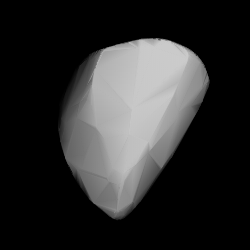 Shape model of Olympiada from its lightcurve | |
| Discovery [1] | |
|---|---|
| Discovered by | V. Albitzkij |
| Discovery site | Simeiz Obs. |
| Discovery date | 23 June 1924 |
| Designations | |
| (1022) Olympiada | |
Named after | Olimpiada Albitskaya [2] (discoverer's mother) |
| 1924 RT ·1928 FQ 1948 QO ·1957 OC 1961 JF ·1962 QK A910 NA | |
| main-belt [1] [3] ·(outer) [4] background [5] | |
| Orbital characteristics [3] | |
| Epoch 23 March 2018 (JD 2458200.5) | |
| Uncertainty parameter 0 | |
| Observation arc | 106.79 yr (39,006 d) |
| Aphelion | 3.2959 AU |
| Perihelion | 2.3144 AU |
| 2.8051 AU | |
| Eccentricity | 0.1749 |
| 4.70 yr (1,716 d) | |
| 10.487° | |
| 0° 12m 35.28s / day | |
| Inclination | 21.054° |
| 111.97° | |
| 124.74° | |
| Physical characteristics | |
| 26.39±2.2 km [6] 26.65 km(derived) [4] 32.88±0.76 km [7] 34.30±0.99 km [8] | |
| 3.822±0.006 h [9] 3.833±0.005 h [10] [a] 3.8331±0.0006 h [11] 3.83359±0.00005 h [12] 3.834±0.001 h [13] 3.835±0.0016 h [14] 4.589±0.002 h(retracted) [15] | |
| 0.105±0.005 [7] 0.125±0.017 [8] 0.1600±0.030 [6] 0.2069 (derived) [4] | |
| SMASS = X [3] [4] | |
| 10.053±0.001(R) [14] 10.20 [3] [4] [8] 10.46±0.26 [16] 10.50 [6] [7] | |
1022 Olympiada, provisional designation 1924 RT, is a background asteroid from the central regions of the asteroid belt, approximately 30 kilometers (19 miles) in diameter. It was discovered at the Simeiz Observatory on the Crimean peninsula on 23 June 1924, by Soviet astronomer Vladimir Albitsky, [1] who named it after his mother, Olimpiada Albitskaya. [2] The X-type asteroid has a short rotation period of 3.83 hours. [4]